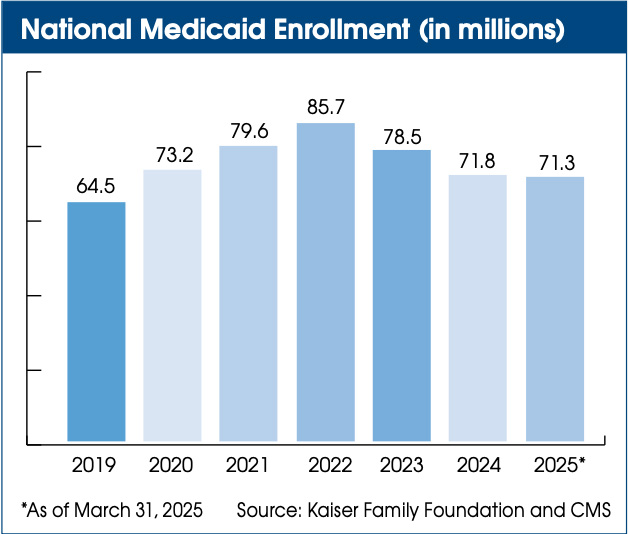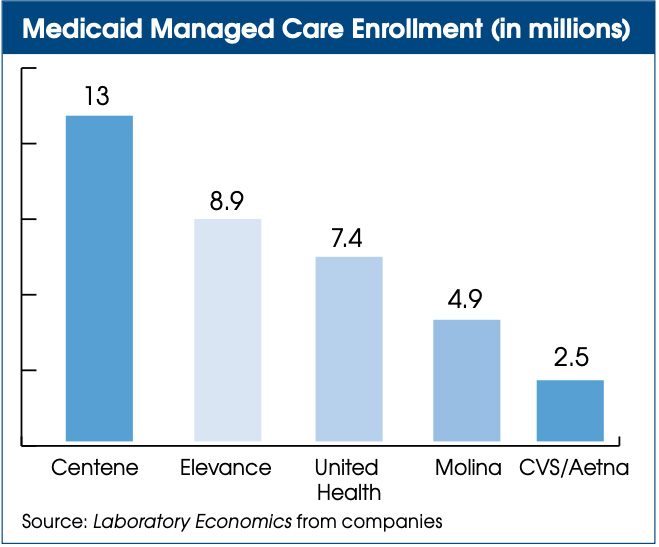- Home»
- Resources»
- Blog Posts»
- Laboratory Economics: How Will Trump’s “Big Beautiful Bill” Impact Labs?

Laboratory Economics: How Will Trump’s “Big Beautiful Bill” Impact Labs?
July 21, 2025The following timely article is reprinted with permission from Laboratory Economics, Jondavid Klipp, editor. We thank them for granting us the right to share their valuable insights on this vital topic. Learn more about Laboratory Economics at www.laboratoryeconomics.com
These cuts will hurt Medicaid-focused providers the most, including labs specializing in nursing homes, toxicology/drugs-of-abuse, women’s health, and prenatal and newborn genetic screening for rare diseases.
 Source: Laboratory Economics from CMS
Source: Laboratory Economics from CMSHowever, A.J. Rice, Healthcare Services Analyst at UBS, notes that most of the major changes do not come into effect until 2027 and 2028. He says this will give providers time to prepare and also opens the door for Congress to delay or amend the law in future years.
Medicaid primarily serves low-income adults, families, children and pregnant women. The loos-ening of Medicaid eligibility restrictions during the pandemic led to a peak in enrollment of 87.4 million in April 2022, according to CMS. Medicaid enrollment has since dropped by 18% to 71.3 million.
The Congressional Budget Office (CBO) has estimated that enacting the Medicaid provisions in the Big Beautiful Bill will increase the number of people without health insurance by 7.8 million in 2034. Here’s the CBO’s breakdown of that number:
Medicaid work requirements are scheduled to begin on January 1, 2027. They require able-bodied adults (age 19-64) who have no dependents to spend at least 80 hours each month working, completing community service, participating in a work program, or enrolling in an educational program. The CBO estimates that these work requirements will increase the number of uninsured people by 4.8 million by 2034.
- Citizenship and immigration status requirements will eliminate Medicaid coverage for an estimated 1.4 million people.
- More frequent eligibility checks (shifting from annual to semi-annual reviews) will lead to 2.2 million people becoming uninsured.
- Adjustments for overlapping policies will reduce the estimated number of people without health insurance by 600,000 in 2034 because some people are affected by more than one policy.
UBS’s Rice believes that the impact on providers should largely be manageable, as the population targeted by the new work rules (healthy working-age individuals) are not high utilizers of health- care services.
Most Medicaid recipients are enrolled in managed care plans owned by commercial insurance companies. The biggest Medicaid managed care company is Centene Corp. (St. Louis, MO), which covered 13 million Medicaid members as of December 31, 2024. The next largest are Elevance Health (Indianapolis IN), 8.9 million, UnitedHealth (Eden Prairie MN), 7.4 million, Molina (Long Beach CA), 4.9 million, and CVS/Aetna (Woonsocket RI), 2.5 million. These companies may seek to lower their Medicaid lab fee schedules to compensate for declining membership.
 Source: Laboratory Economics from CMS
Source: Laboratory Economics from CMSOverall, the CBO estimates that the Big Beautiful Bill Act will reduce federal spending on healthcare by $1.124 trillion between 2025 and 2034. Despite these cuts the CBO estimates that federal government spending on Medicaid will still grow from $655.9 billion in 2025 to $860.5 billion in 2034, or an average of 3.1% per year.